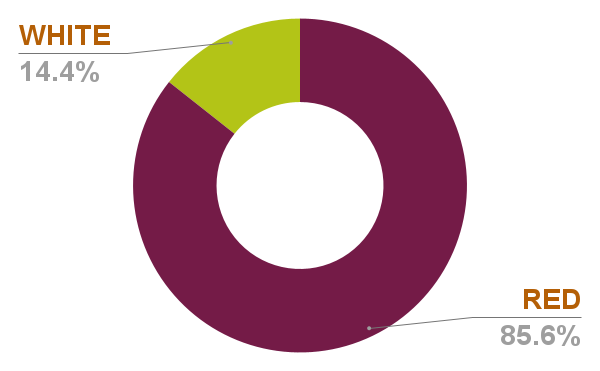By the numbers
-
12AVAs
-
200+Physical Wineries
-
8%Total Plantings
-
35,578Acreage Under Vine (Acres)
-
12AVAs
-
200+Physical Wineries
-
8%Total Plantings
-
14,398Acreage Under Vine (Hectares)

Overview
If there is one word that best describes Paso Robles, it’s “diversity.” Paso Robles as a wine region is many things, though also unique unto itself. The name, incidentally, means “Oak Pass,” or “Pass of the Oaks” in Spanish. Despite the Spanish origin though, locals pronounce Robles as ROE-bulls rather than ROW-bless.
While Cabernet Sauvignon, Merlot, Syrah and Zinfandel are the region’s predominant grapes, Paso Robles’ grape-friendly terroirs have proven conducive to over 60 other wine grapes grown for commercial use. Plantings of Rhône varieties have increased steadily since the 1990s, especially since Tablas Creek (co-owned by France's Château de Beaucastel) began planting 12 of the classic Châteauneuf-du-Pape varieties, including Picardan, Bourboulenc, Clairette Blanche, Marsanne, Roussanne, Terret Noir and Counoise, turned into both blends and varietal bottlings.
Spanish grapes such as Tempranillo, Graciano and Albariño have also found a home in Paso Robles, as have many other varieties, including Aglianico, Alicante Bouschet, Arneis, Picpoul, Trousseau, Valdiguié, Verdelho, Vermentino, and Vernaccia ... adding up to one of the most varied and diverse wine regions in the world.
There are 11 nested AVAs in Paso Robles, a reflection of the region’s varied topography and climate. Paso Robles lies on the inland or eastern side of the Santa Lucia coastal mountains in San Luis Obispo County. Plantable sites range from steep slopes and mountaintops to rolling hills, flat plains, terraces and old river beds, with aspects in all directions.
While daytime temperatures during the growing season can be described as warm or hot, Paso Robles also experiences the coolest night temperatures found in any major California wine region. Daily temperature swings of up to 33° C (50 °F) in the hottest months, July and August, are not unheard of. This factor has a huge impact on sensory qualities; while Paso Robles’ wines are diverse, they are, almost as a rule, fresh and intense, yet very well-balanced.
Vineyard elevations range between 213-609 m (700-2,000 feet) above sea level. There are some signature soil types associated with Paso Robles, such as the Linne Calodo series (a shallow, rocky, calcareous soil distinguished by its high pH -- as much as 8.5 -- conducive to low-pH grapes, and wines high in total acidity), but because of this coastal region’s complex geology, most vineyard sites are convergences of multiple soil types, often combinations of calcareous and siliceous, or clay and sandy loams.
As in other California wine regions, the history of winegrowing in Paso Robles can be traced back to Franciscan monks, who established a mission in 1787 along California's historic El Camino Real in the Santa Margarita area, at the southern end of the present-day Paso Robles AVA. The first commercial plantings of Vitis vinifera, however, were undertaken after California achieved statehood in 1850. There are early plantings of Zinfandel, notably the Ueberroth Vineyard, established as far back as 1885 in Paso Robles’ Willow Creek District, the Benito Dusi Ranch in the Templeton Gap District, dating back to 1925, and the Dante Dusi Vineyard, also in the Templeton Gap District, planted in the 1940s. All three remain extremely productive to this day. This is the enduring heritage of Paso Robles.
In the 1960s, Dr. Stanley Hoffman planted Chardonnay, Pinot Noir and Cabernet Sauvignon on hillsides in the Adelaida District. During the mid-1970s, California's first major planting of Syrah took place on the site of the Estrella River Winery estate (no longer in operation) in what has become the Paso Robles Estrella District. Because of its early adoption and propagation, the Estrella clone of Syrah is the most widely planted selection of this grape in the state. The clone is late-ripening and thus excellent for warm climates. It produces wines with jammy dark fruit flavors and soft tannins.
In the 1980s, Cabernet Sauvignon and attendant Bordeaux varieties began to dominate the rapid growth within the 247,668-ha (612,000-acre) zone defining the Paso Robles appellation, of which just over 16,600 ha (41,000 acres) are now under vine.
